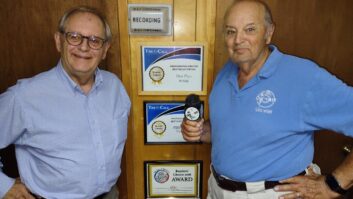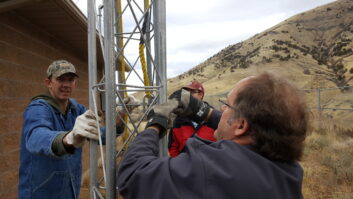From the land Down Under comes the Patriot POTS codec, courtesy of Tieline Codec Solutions in Australia and distributed in the United States by Tieline America, a Tieline Technology company.
While coming from Australia has a definite conversational angle, the units are serviced in the United States, in Indianapolis. If necessary, loaner units are provided within the same day, so downtime is not going to be an issue.
Product CapsuleThumbs Up
Simplicity of operation
Up to 15 kHz response
High-quality components
Extensive and desirable feature set
Thumbs Down
Zippering on volume pots
Some artifacts on spoken word and percussive audio, line dependent
For information contact Tieline in Indiana at (317) 259-8000, fax (317) 259-8040 or visit www.tieline.com
With one of the simplest panels around, the Patriot is jock-friendly. The straightforward rear panel makes it simple to hook up and hit the air quickly after arriving at a remote site.
The Patriot ($2,595 list price) comes close to another Tieline product, the Commander codec, minus ISDN compatibility and rack mounting. The Patriot does come with its own feature set that makes it attractive to a station engineer seeking a decent POTS codec for those car dealer remotes, football games and weekend jock appearances.
With a claimed 15 kHz response on bit rates as low as 24 kbps, the Patriot can be used to send music down the line with sufficient fidelity for AM and just enough to swing FM. The Patriot also can connect as low as 9,600 bps.
There are some caveats, which will be discussed below. Suffice it to say the Patriot performs its tasks admirably in an easy-to-use package.
Guts
The Patriot is constructed in a blue-enameled slant-top chassis, with a footprint slightly larger than an old 45-rpm record jacket.
Two circuit boards are connected by a 40-pin ribbon connector, the same as is found in computers. The top board contains the function buttons, four pots, a rotary encoder and a backlit LCD display. Big rubber buttons make up the DTMF telephone pad and the function buttons, and all have a positive tactile “click” feel when pressed. The bottom board is where the brainpower resides.
The semiconductor complement inside the Patriot reads like a “Who’s Who” of the chip world. High-quality SMD components are running the show inside the unit, including two Analog Devices 2106 SHARC DSPs, several audio ICs from Analog Devices and National Semiconductor, a few Exar brand UARTs, six Cypress Async SRAM memory chips and a Conexant modem/data pump sending data down the phone line.
Internal construction is first rate and the PC boards are well mounted and ready for some knocking around in the gig bag.
The top panel offers two input pots, a Send and Return pair (for headphone monitoring of audio going out as well as mix-minus foldback from the station), the display with its extensive menu hierarchy, and the big dial-and-click selector encoder.
Once the menus are set, there is little reason to reenter them; the on-site operator must only be concerned with dialing and connecting.
The rear connections offer no confusion as to what gets connected where. A mini-DIN plug takes power from the line-lump supply. A single 1/4-inch headphone jack allows monitoring of the Send and Receive signals.
A mic/line selectable XLR input jack takes a single mic signal or the output from an external mixer, and is controlled by the Input 1 pot. An XLR output plug can feed a PA system or a recorder for the client to have a record of the day’s broadcast.
Of interest are two additional sets of jacks. One is a cellphone plug that allows bidirectional operation of the Patriot over a wireless telephone, and a pair of RCA unbalanced input jacks for feeding in an external device.
The former is handy, but only allows phone-quality broadcasts. The data rates of cellphones and those of POTS codecs cannot fully talk to each other yet, so it remains impossible to get 15 kHz over a cellphone.
The latter lets a broadcaster connect a MiniDisc or cassette deck into the Patriot (for playing back the coach’s comments recorded before the big game) or a laptop computer soundcard (when the morning show sound effects collection comes along for the ride). This source is handled by the Input 2 pot.
Last on the back is the RS-232 interface port. Using software downloaded from Tieline, the Patriot can talk with a PC to determine and graph changes in line quality, keep an extensive phonebook of numbers the unit could call (on its own, the Patriot has a 50-number capacity), allows configuration of the unit by bypassing the displayed menu items, and can “chat” with the operator/screener at the other end of the line.
Wired and running
My evaluation consisted of connecting the Patriot units to two local telephones in the greater Washington area and sending various types of program audio down the line.
The manual suggests that a connection of 28 kbps with a line quality of 70 percent was typical and would give ideal results. According to the company, the connections of the Patriot have been improved since the manual was written. Tieline now recommends a line quality of only 35 percent to obtain a stable connection.
Given local telephone use and typical congestion of the system in our area in general, the best connection I could achieve was 26.4 kbps, with a line quality averaging much lower – about 48 percent, within the newer guidelines.
Car manufacturers often say “your mileage may vary,” and indeed that is the case here. My experience has shown that, quite often, better connections and higher bit rates can occur on long-distance hauls. But more often than not, remote broadcasts are a local affair, with little more than a call placed from crosstown or into the next exchange.
Just the same, a 26.4 connection is nothing to make fun of, and I enjoyed considerable success over it.
My first check consisted of spoken-word transmissions and playback of some produced material. Fidelity at the other end was broadcast-quality, although I did experience some slight high-pitched ringing and artifacts on the voice. I can chalk much of that up to the iffy line quality and the attempts of the Patriot to correct for the losses and “fill in the holes.”
The artifacts became more obvious when I played a spoken commercial containing a solo drumtrack down the line. High-frequency content, such as hi-hat cymbals and tambourines, became chirpy and slightly smeared. Again, not totally a fault of the box, but line conditions which are out of my control.
Music seemed to fare somewhat better. With dense program material (i.e., loud classical music), the edginess I noted on spoken-word audio was less obvious.
Ancillary application
This led me to an obvious ancillary application for the Patriot: a backup line-based STL should a station’s primary STL be lost. As long as a phone line can make it up to the tower site, and as long as a loss of stereo is not much of an issue during an emergency, the Patriot can come to your rescue if needed.
Tieline claims dozens of stations are using the Patriot as their main STLs. Some of these stations are FMs, a large shortwave station and AM stations. One TV station uses it for morning traffic audio.
I also noticed some “zippering” of the volume pots on the Send end. In varying the level of the Input control and the Send monitoring, I was aware of the audio stepping to its level, rather than gradually fading to it. Tieline says it intends to address this zippering effect with software upgrades that will smooth it out.
If you use a Patriot at a remote, you must tie directly to an analog line. Digital phones potentially can fry the unit. Also, it is necessary to disable Call Waiting and turn off extension phones at the remote site. Either one can cause a connection to be dropped.
Fortunately, the Patriot will redial the number and attempt to reconnect to the receiving end should the line go down.
Products such as the Patriot would not be fully appropriate as lower-cost alternatives to ISDN devices such as the Telos Systems Zephyr line. For immediate live broadcasts, yes, but as a high-quality delivery device in voiceover studios or airing of full-bandwidth stereo music, no. Some products remain better than others for their intended purposes.
Observations
I have almost no quibbles about the Patriot. In fact, I enjoyed testing it out. There is something about getting 15 kHz audio out of a system designed for maximum 3 kHz that I find entertaining.
The presence of digital artifacts on compressed audio pumped down the phone is just a way of life for us right now. They can be minimized, but line conditions often force the issue. Metaphorically speaking, it is difficult to stuff that much sausage down such a little tube, although the unit tries hard.
When trying to handshake the line and settle on a data rate, the Patriot will engage audio, then mute out and step up to the next allowable level. As long as you don’t have to fire up the unit and be on the air immediately, give the system a moment to settle out and pick a rate everybody can live with.
There is no shame in ending up with a rate lower than the ideal. At a connect rate in the 19 kbps range, my line quality was better and voice transmission still sounded fine and was perfectly airable.
Obviously, lower bit rates cost you fidelity in the upper end, but the connection seems more stable. In fact, you may manually dial in the range you wish as well as select a codec optimized for music or for speech.
Engineers read manuals; jocks do not. As the box was designed to be brought out and run by Mr. Morning and the promotions manager, the inclusion of a quick-start sheet (also unfairly called an “idiot card”) would be a welcome addition. Not much, just a laminated card with some basic troubleshooting tips and a simplified diagram of the gazintas and the gazoutas.
This is not meant to replace instructions created by the station engineer for unique applications the Patriot may be put through, just enough to make things easier.
One item in the manual gave me pause for thought. In order for the Patriot to operate at its best, other devices with the potential for adding interference must be removed from the line. One piece mentioned is “clandestine devices.” Well, forgive my observation, but how would you know if a clandestine device was tied to the line, much less try to remove it? And why would the boss have such a device tied to the line in the first place?
Not enough inputs for your taste? Connect a small mixer to the Patriot. It was intended for fast set up and go, and multiple inputs add expense while not always needed by everybody.
With the telephone company all but out of the business of leasing full-bandwidth analog audio lines, a POTS codec is the only way to go today without engaging in the expense and hassle of setting up a temporary ISDN line at a remote site.
The Tieline Patriot is an effective solution. As it uses a proprietary coding algorithm, I suspect the unit will not talk to other manufacturers’ devices (such as a Comrex product), so if you obtain a Patriot, you will likely only be able to talk to another Tieline codecs.
The trend for POTS codecs these days is to be as easy to use as possible, allowing a single talent to set up a remote with little effort. Products such as the Tieline Patriot make this possible and deserving of your attention.





